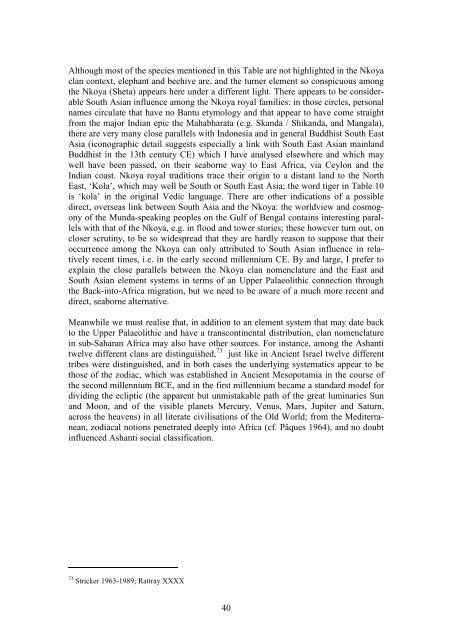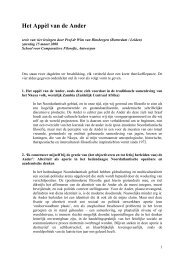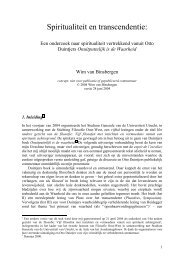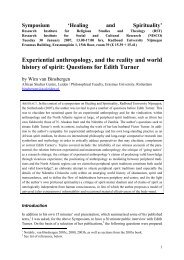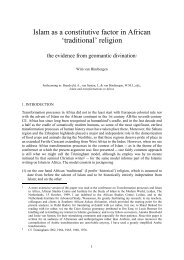Izanami giving birth to Kagutsuchi / Fire - Shikanda.net
Izanami giving birth to Kagutsuchi / Fire - Shikanda.net
Izanami giving birth to Kagutsuchi / Fire - Shikanda.net
Create successful ePaper yourself
Turn your PDF publications into a flip-book with our unique Google optimized e-Paper software.
Although most of the species mentioned in this Table are not highlighted in the Nkoya<br />
clan context, elephant and beehive are, and the turner element so conspicuous among<br />
the Nkoya (Sheta) appears here under a different light. There appears <strong>to</strong> be considerable<br />
South Asian influence among the Nkoya royal families: in those circles, personal<br />
names circulate that have no Bantu etymology and that appear <strong>to</strong> have come straight<br />
from the major Indian epic the Mahabharata (e.g. Skanda / <strong>Shikanda</strong>, and Mangala),<br />
there are very many close parallels with Indonesia and in general Buddhist South East<br />
Asia (iconographic detail suggests especially a link with South East Asian mainland<br />
Buddhist in the 13th century CE) which I have analysed elsewhere and which may<br />
well have been passed, on their seaborne way <strong>to</strong> East Africa, via Ceylon and the<br />
Indian coast. Nkoya royal traditions trace their origin <strong>to</strong> a distant land <strong>to</strong> the North<br />
East, ‘Kola’, which may well be South or South East Asia; the word tiger in Table 10<br />
is ‘kola’ in the original Vedic language. There are other indications of a possible<br />
direct, overseas link between South Asia and the Nkoya: the worldview and cosmogony<br />
of the Munda-speaking peoples on the Gulf of Bengal contains interesting parallels<br />
with that of the Nkoya, e.g. in flood and <strong>to</strong>wer s<strong>to</strong>ries; these however turn out, on<br />
closer scrutiny, <strong>to</strong> be so widespread that they are hardly reason <strong>to</strong> suppose that their<br />
occurrence among the Nkoya can only attributed <strong>to</strong> South Asian influence in relatively<br />
recent times, i.e. in the early second millennium CE. By and large, I prefer <strong>to</strong><br />
explain the close parallels between the Nkoya clan nomenclature and the East and<br />
South Asian element systems in terms of an Upper Palaeolithic connection through<br />
the Back-in<strong>to</strong>-Africa migration, but we need <strong>to</strong> be aware of a much more recent and<br />
direct, seaborne alternative.<br />
Meanwhile we must realise that, in addition <strong>to</strong> an element system that may date back<br />
<strong>to</strong> the Upper Palaeolithic and have a transcontinental distribution, clan nomenclature<br />
in sub-Saharan Africa may also have other sources. For instance, among the Ashanti<br />
twelve different clans are distinguished, 73 just like in Ancient Israel twelve different<br />
tribes were distinguished, and in both cases the underlying systematics appear <strong>to</strong> be<br />
those of the zodiac, which was established in Ancient Mesopotamia in the course of<br />
the second millennium BCE, and in the first millennium became a standard model for<br />
dividing the ecliptic (the apparent but unmistakable path of the great luminaries Sun<br />
and Moon, and of the visible pla<strong>net</strong>s Mercury, Venus, Mars, Jupiter and Saturn,<br />
across the heavens) in all literate civilisations of the Old World; from the Mediterranean,<br />
zodiacal notions pe<strong>net</strong>rated deeply in<strong>to</strong> Africa (cf. Pâques 1964), and no doubt<br />
influenced Ashanti social classification.<br />
73 Stricker 1963-1989; Rattray XXXX<br />
40


